Messier Monday: A Titan in a Teapot, M69
An ancient relic from the young Universe is covered in surprising riches near the galactic center.
Image credit: Paul Chasse (astronewb11) of flickr, via https://www.flickr.com/photos/astronewb2011/7247070648/.
“Ancients knew that you need guidance, patronage and protection as you move from one place or state to another, whenever you cross a bridge.” -Richard Rohr
When you look up at the night sky, you find that it’s littered with stars. If you look a little deeper — beyond, perhaps, what you can see with your naked eye — you find that it’s filled with clusters, nebulae and galaxies, some of which are only thousands of years old while others are nearly as old as the Universe itself. This Messier Monday, let’s have a look at one of the most ancient oddities we’ve ever discovered.
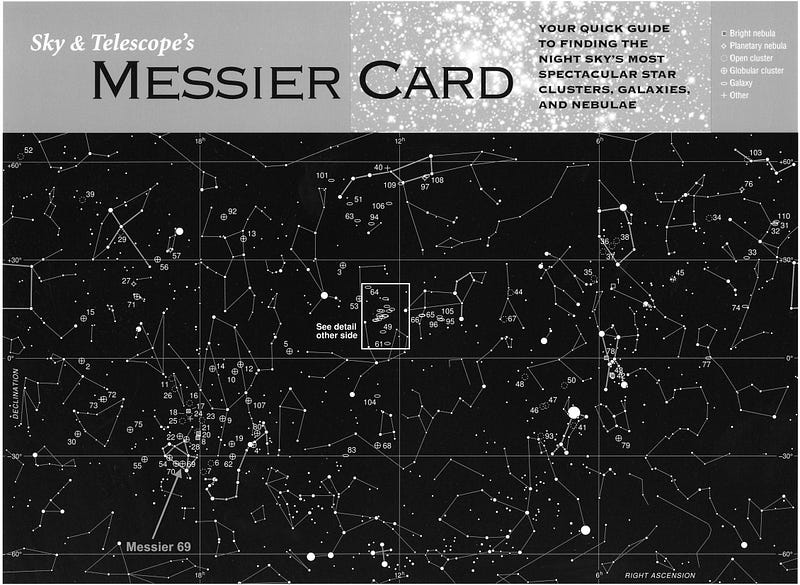
You see, the Universe started off composed almost entirely of hydrogen and helium, and so the first stars that formed were practically metal-free, having very little iron, for example. So you’d expect that if we find a star cluster that’s ancient — that formed when the Universe was less than a billion years old — its stars would have very little iron, too. That’s the case, in fact, for most of them, but every once in a while, there’s an exception. Today, let’s have a look at one of the most puzzling objects in our galaxy and its cosmic story: Messier 69. Here’s how to find it.
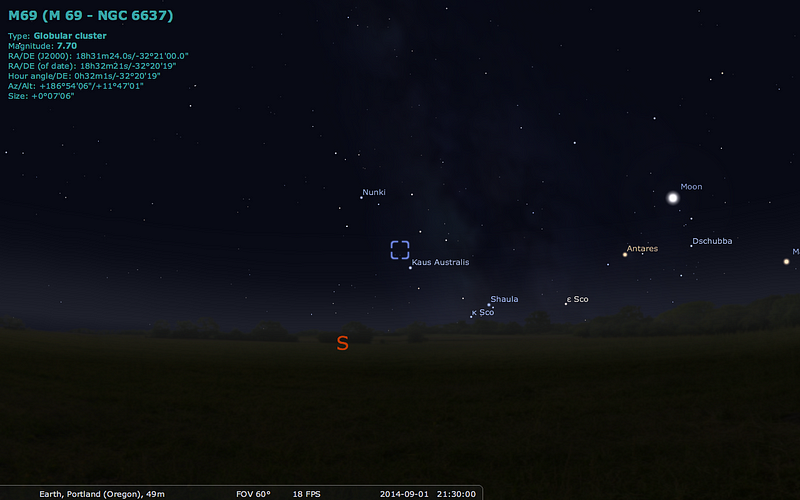
After sunset tonight, the sky will darken with the Moon hovering low on the horizon in the southwest. Due south, however, you’ll find the constellation of Sagittarius, heralded by a collection of stars that looks like a teapot, one of the most recognizable asterisms of the summer-and-early-autumn skies. If you’re at high northern latitudes, these stars will appear low on the horizon and will therefore be washed out by the atmosphere, appearing dimmer than they would otherwise. Nevertheless, look towards the lowest star on the teapot: the one at the foot of the spout.
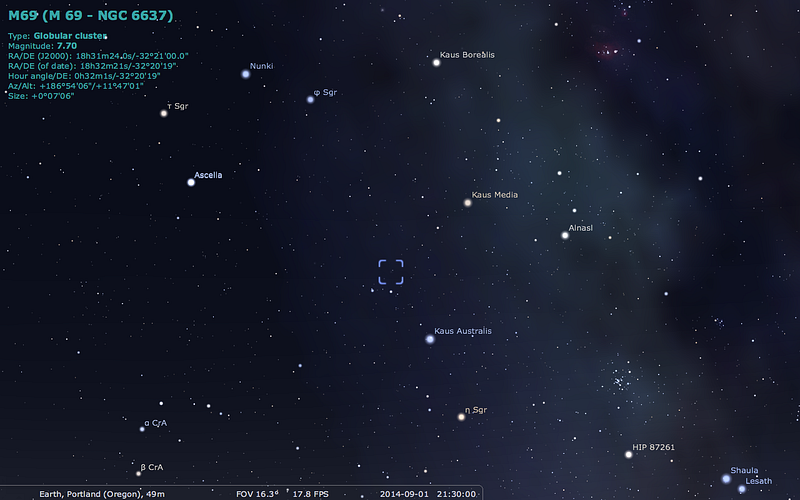
That’s Kaus Australis, a luminous blue giant that’s the brightest star in the entire constellation, and your starting point to find Messier 69. If you follow the imaginary line across the teapot’s bottom (towards Ascella), you’ll come to two stars that are brighter than all the others in between Kaus Australis and Ascella: HIP 91014 and HIP 90763. Look just north of the latter one — the one closer to Kaus Australis — and a fuzzy-looking star that won’t quite focus will appear.
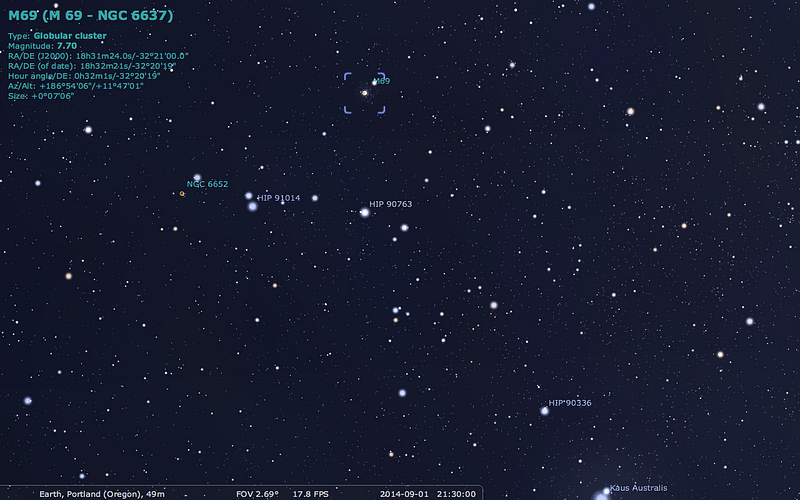
That’s Messier 69, one of many original discoveries by Charles Messier himself! His discovery notes attest to how faint it appears from northern latitudes when it’s low on the horizon:
Nebula without star, in Sagittarius, below his left arm & near the arc; near it is a star of 9th magnitude; its light is very faint, one can only see it in good weather, & the least light employed to illuminate the micrometer wires makes it disappear.
Nevertheless, if you can find it, its sights are tremendously rewarding!
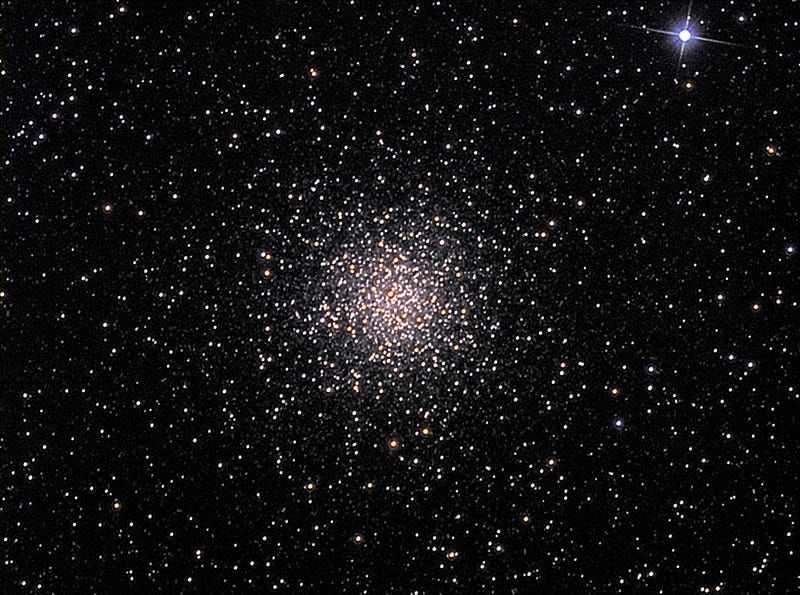
When you look at a large collection of stars like this — in this case, hundreds of thousands of them — you can measure their colors and brightnesses to determine just how old and evolved the stars inside are. When a star cluster first forms, it contains all the different classes of stars, from the brightest and bluest down to the dimmest and reddest: O, B, A, F, G, K, and M, in descending order. As the stars age, they start to evolve and die: first the Os, then the Bs, and so on. As the blue stars disappear, the cluster turns white, and will eventually turn yellow, orange and even red as time goes on.
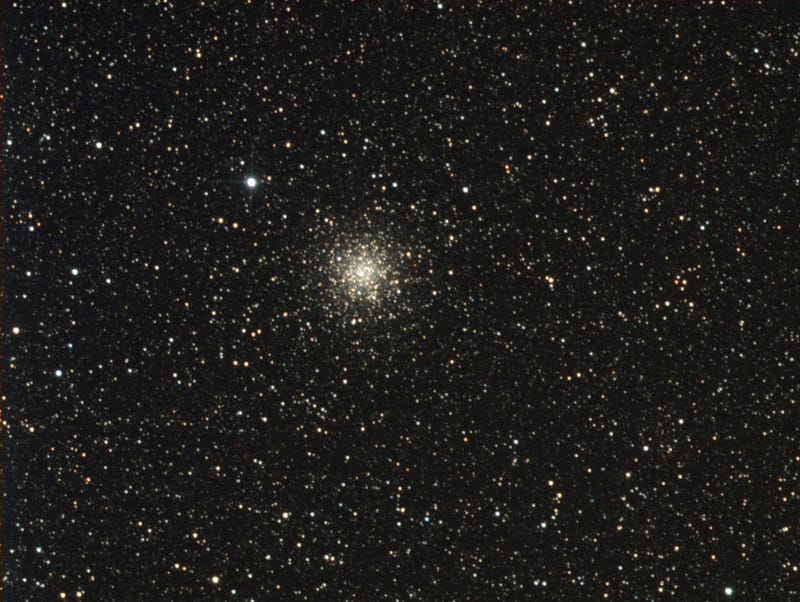
Messier 69 is so old that all the O, B, A, and even F-class stars have run through their entire life cycles. Even the brightest and bluest G-stars have died; the most massive main-sequence stars left in Messier 69 are G2-stars, the same class as our humdrum Sun. That places the age of this cluster at around 13.1 billion years, meaning that the stars in here formed when the Universe was only 700 million years old!

This isn’t that strange; globular clusters are often among the oldest objects known in the Universe, and even the Messier catalogue contains some that are older than this one. But when we look at the elements present inside, that’s where Messier 69 starts to look funny.
You see, our Sun formed relatively late in the history of the Universe, meaning that many generations of stars have had the chance to live-and-die prior to the Sun’s creation, enriching the environment in which we formed with riches of the heavier elements in the periodic table. The globular clusters that formed early on didn’t have this, with some containing just 1% of the heavy elements found in the Sun.
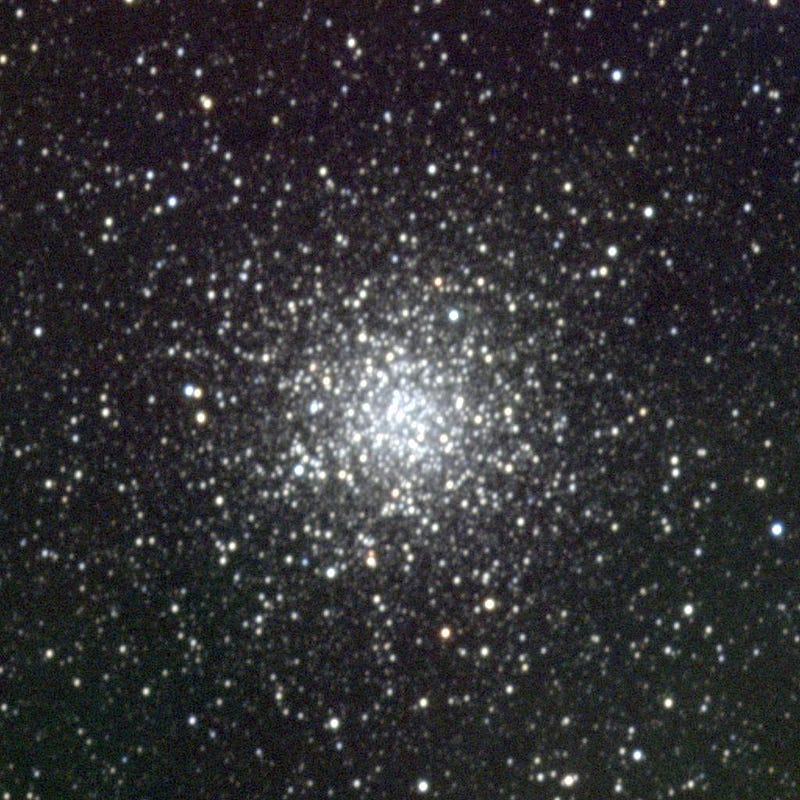
So why is it, then, when we look at this object — formed so long ago — that it contains 22% of the amount of iron our Sun has, or more than ten times as much as the other globulars of a comparable age?
The key, as any real estate agent (cosmic or terrestrial) will tell you, is location! This globular cluster isn’t located in the galactic halo or in the outskirts of the Milky Way like most of them, but rather very close to the galactic core: only 6,200 light-years away, compared to 25,000 for us. Therefore, it’s associated with the galactic bulge, a location that evolves much more quickly in terms of heavy elements and the number of generations of stars that pass by than any other in our galaxy.
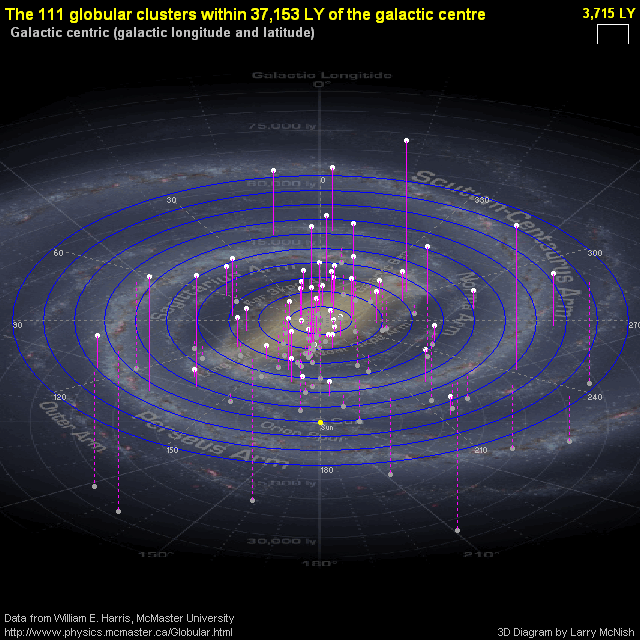
In fact, the globulars that we do find in the galactic bulge — and there are a handful of them — show that they’re all more metal-rich for their ages than any other globulars within our galaxy. So that’s the resolution to the mystery: this object is as old as it looks, but the place where it formed in the Universe (the center of our galaxy) aged much more quickly in terms of forming heavy elements than everywhere else. That’s why, if you only used the heavy element abundance, this cluster would fool you into thinking it formed later than it really did!
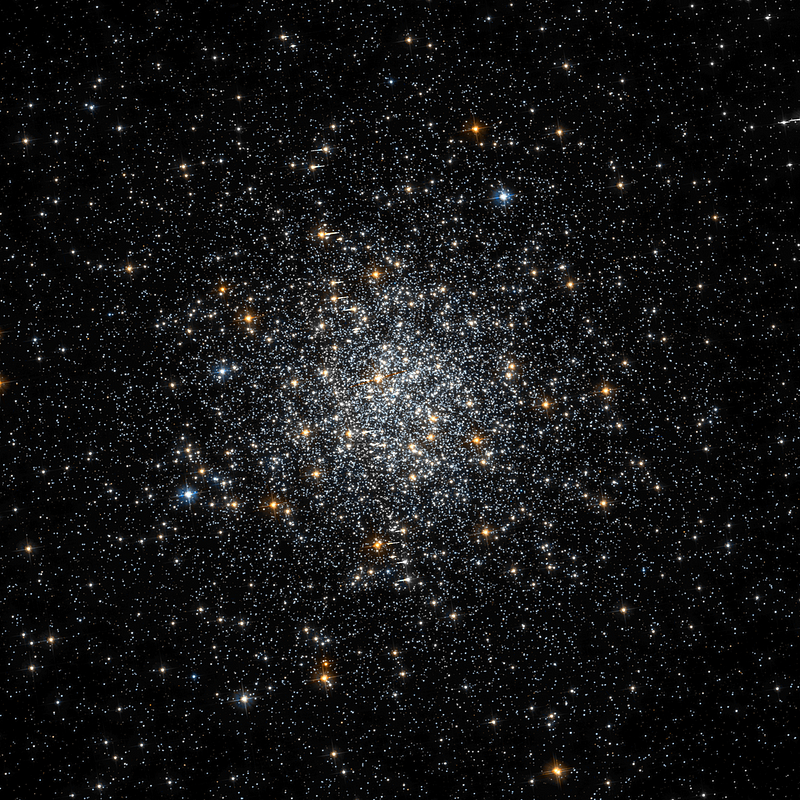
This cluster — although quite old — is relatively typical for globular clusters in most other ways. It contains a smattering of red giants, which is what happens to evolved stars when they run out of hydrogen in their core, it’s of about average concentration towards the core (class V on a scale of I to XII), and about the only other “oddity” in here is how few variable stars it has: only about a dozen are known. Considering the advanced age and the 30,000 light-year distance to this ancient relic, that might not be too surprising!
The best view I can give you for appreciating just how rich a globular cluster is in its central region — even in a modestly concentrated object like this — comes courtesy of the Hubble Space Telescope, and is certainly worth taking your time with.

And with that spectacular view of this unusually rich, ancient globular, we’ll come to the end of today’s Messier Monday! Including today’s object, we’ve covered 98 out of the 110 deep-sky wonders in the Messier catalogue. Have a look back at all our previous Messier Mondays:
- M1, The Crab Nebula: October 22, 2012
- M2, Messier’s First Globular Cluster: June 17, 2013
- M3, Messier’s First Original Discovery: February 17, 2014
- M4, A Cinco de Mayo Special: May 5, 2014
- M5, A Hyper-Smooth Globular Cluster: May 20, 2013
- M6, The Butterfly Cluster: August 18, 2014
- M7, The Most Southerly Messier Object: July 8, 2013
- M8, The Lagoon Nebula: November 5, 2012
- M9, A Globular from the Galactic Center: July 7, 2014
- M10, A Perfect Ten on the Celestial Equator: May 12, 2014
- M11, The Wild Duck Cluster: September 9, 2013
- M12, The Top-Heavy Gumball Globular: August 26, 2013
- M13, The Great Globular Cluster in Hercules: December 31, 2012
- M14, The Overlooked Globular: June 9, 2014
- M15, An Ancient Globular Cluster: November 12, 2012
- M18, A Well-Hidden, Young Star Cluster: August 5, 2013
- M19, The Flattened Fake-out Globular: August 25, 2014
- M20, The Youngest Star-Forming Region, The Trifid Nebula: May 6, 2013
- M21, A Baby Open Cluster in the Galactic Plane: June 24, 2013
- M23, A Cluster That Stands Out From The Galaxy: July 14, 2014
- M24, The Most Curious Object of All: August 4, 2014
- M25, A Dusty Open Cluster for Everyone: April 8, 2013
- M27, The Dumbbell Nebula: June 23, 2014
- M29, A Young Open Cluster in the Summer Triangle: June 3, 2013
- M30, A Straggling Globular Cluster: November 26, 2012
- M31, Andromeda, the Object that Opened Up the Universe: September 2, 2013
- M32, The Smallest Messier Galaxy: November 4, 2013
- M33, The Triangulum Galaxy: February 25, 2013
- M34, A Bright, Close Delight of the Winter Skies: October 14, 2013
- M36, A High-Flying Cluster in the Winter Skies: November 18, 2013
- M37, A Rich Open Star Cluster: December 3, 2012
- M38, A Real-Life Pi-in-the-Sky Cluster: April 29, 2013
- M39, The Closest Messier Original: November 11, 2013
- M40, Messier’s Greatest Mistake: April 1, 2013
- M41, The Dog Star’s Secret Neighbor: January 7, 2013
- M42, The Great Orion Nebula: February 3, 2014
- M44, The Beehive Cluster / Praesepe: December 24, 2012
- M45, The Pleiades: October 29, 2012
- M46, The ‘Little Sister’ Cluster: December 23, 2013
- M47, A Big, Blue, Bright Baby Cluster: December 16, 2013
- M48, A Lost-and-Found Star Cluster: February 11, 2013
- M49, Virgo’s Brightest Galaxy: March 3, 2014
- M50, Brilliant Stars for a Winter’s Night: December 2, 2013
- M51, The Whirlpool Galaxy: April 15th, 2013
- M52, A Star Cluster on the Bubble: March 4, 2013
- M53, The Most Northern Galactic Globular: February 18, 2013
- M56, The Methuselah of Messier Objects: August 12, 2013
- M57, The Ring Nebula: July 1, 2013
- M58, The Farthest Messier Object (for now): April 7, 2014
- M59, An Elliptical Rotating Wrongly: April 28, 2014
- M60, The Gateway Galaxy to Virgo: February 4, 2013
- M61, A Star-Forming Spiral: April 14, 2014
- M62, The Galaxy’s First Globular With A Black Hole: August 11, 2014
- M63, The Sunflower Galaxy: January 6, 2014
- M64, The Black Eye Galaxy: February 24, 2014
- M65, The First Messier Supernova of 2013: March 25, 2013
- M66, The King of the Leo Triplet: January 27, 2014
- M67, Messier’s Oldest Open Cluster: January 14, 2013
- M68, The Wrong-Way Globular Cluster: March 17, 2014
- M69, A Titan in a Teapot: September 1, 2014
- M71, A Very Unusual Globular Cluster: July 15, 2013
- M72, A Diffuse, Distant Globular at the End-of-the-Marathon: March 18, 2013
- M73, A Four-Star Controversy Resolved: October 21, 2013
- M74, The Phantom Galaxy at the Beginning-of-the-Marathon: March 11, 2013
- M75, The Most Concentrated Messier Globular: September 23, 2013
- M77, A Secretly Active Spiral Galaxy: October 7, 2013
- M78, A Reflection Nebula: December 10, 2012
- M79, A Cluster Beyond Our Galaxy: November 25, 2013
- M80, A Southern Sky Surprise: June 30, 2014
- M81, Bode’s Galaxy: November 19, 2012
- M82, The Cigar Galaxy: May 13, 2013
- M83, The Southern Pinwheel Galaxy, January 21, 2013
- M84, The Galaxy at the Head-of-the-Chain, May 26, 2014
- M85, The Most Northern Member of the Virgo Cluster, February 10, 2014
- M86, The Most Blueshifted Messier Object, June 10, 2013
- M87, The Biggest One of them All, March 31, 2014
- M88, A Perfectly Calm Spiral in a Gravitational Storm, March 24, 2014
- M89, The Most Perfect Elliptical, July 21, 2014
- M90, The Better-You-Look, The Better-It-Gets Galaxy, May 19, 2014
- M91, A Spectacular Solstice Spiral, June 16, 2014
- M92, The Second Greatest Globular in Hercules, April 22, 2013
- M93, Messier’s Last Original Open Cluster, January 13, 2014
- M94, A double-ringed mystery galaxy, August 19, 2013
- M95, A Barred Spiral Eye Gazing At Us, January 20, 2014
- M96, A Galactic Highlight to Ring in the New Year, December 30, 2013
- M97, The Owl Nebula, January 28, 2013
- M98, A Spiral Sliver Headed Our Way, March 10, 2014
- M99, The Great Pinwheel of Virgo, July 29, 2013
- M100, Virgo’s Final Galaxy, July 28, 2014
- M101, The Pinwheel Galaxy, October 28, 2013
- M102, A Great Galactic Controversy: December 17, 2012
- M103, The Last ‘Original’ Object: September 16, 2013
- M104, The Sombrero Galaxy: May 27, 2013
- M105, A Most Unusual Elliptical: April 21, 2014
- M106, A Spiral with an Active Black Hole: December 9, 2013
- M107, The Globular that Almost Didn’t Make it: June 2, 2014
- M108, A Galactic Sliver in the Big Dipper: July 22, 2013
- M109, The Farthest Messier Spiral: September 30, 2013
And join us next week as we begin counting down the final 12 Messier objects, each one with its own, unique story, only here on Messier Monday!
Leave your comments at the Starts With A Bang forum on Scienceblogs!





